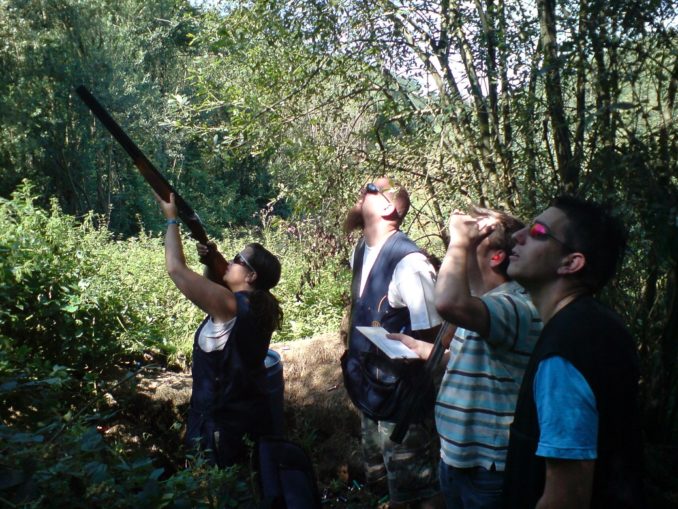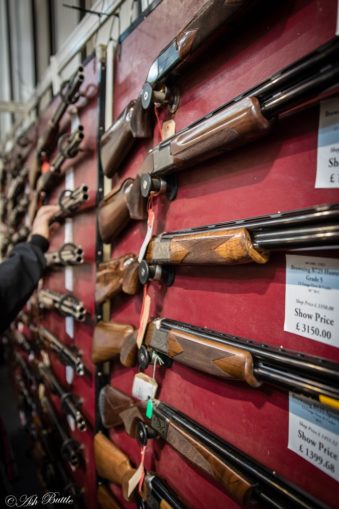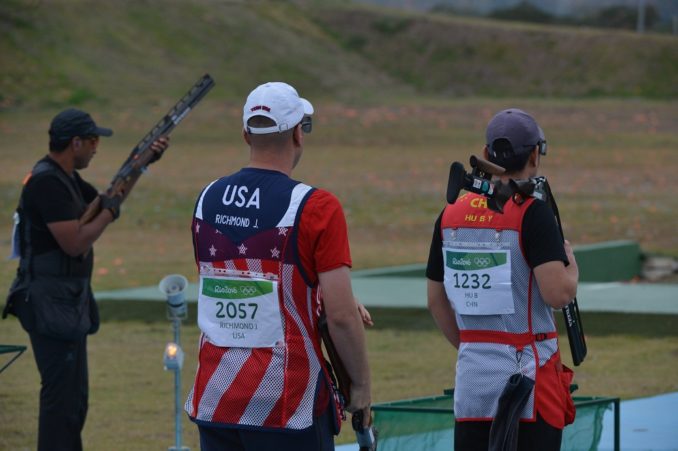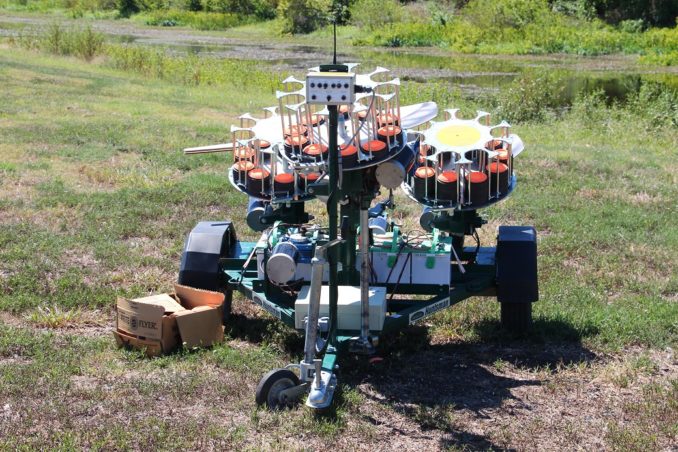I hope I’ve managed to drag a few readers along from the first part, and for this next exercise, we will take a hypothetical Puffin on a journey from someone who has developed a taste for Clay shooting, to a fully addicted clay busting monster. Our Puffin or Puffinette has had a few lessons, mastered the basics and is now ready to move to the next level, and if you would like to discover just how they will go about it, read on…

“Clay Pigeon Shooting With ProAdventure” by ProAdventure is licensed under CC BY 2.0
First things first, let’s talk about legalities. It was fine for the beginner to shoot without a certificate, because they were under supervision at an accredited shooting ground using a borrowed gun and ammunition. This is perfectly legal and how most people would start out. But what if they want to branch out and practice on their own? Or they have a buddy that shoots and fancies shooting the odd round or two together? In this case, he or she may require their own certificate. The fundamental principle of the Shotgun Certificate is that it is a right to be granted one, and not a privilege. I won’t bore you with too much detail, as it’s a relatively straight forward affair. It requires the completion of a form obtained from your local constabulary, a referee of good character to vouch for you and a home visit from a firearms officer. Subject to your approval from the chief constable (and a fee of around £80), There may be an additional cost associated with a medical records check, but this varies from force to force. The whole process should be done and dusted in a few weeks and hopefully, you are fully licensed up for the next five years, and a whole new world is open to you.
Now you are free to practice whenever you want, and you can even venture out on your own at certain grounds, but why would you want to do that? For me, it’s as much about socialising as it is about honing ones technique and striving for mastery. It’s very much to the individuals taste, but my own take on clay shooting is that it is best enjoyed in a group with a bit of light hearted banter thrown in, It never hurts to have a few pairs of eyes to watch what you are doing, as they may be able to steer you back on course if your aim goes off target. Don’t get me wrong, it’s never a substitute for an hour with a good coach, but it can make a difference. So join a club, meet some people, if you see another solo shooter out on the ground, talk to them and see if they want some company. There’s always someone at a clay ground that wouldn’t mind ‘squadding up’, even if it’s just to sus out the new guy.

“clay shoot 26/08/2007” by big-ashb is licensed under CC BY 2.0
For the shooter starting out, I would never recommend spending fortunes on a gun because you will not find the right one first time around. I’ve probably owned 30 different guns in the 25 odd years I’ve been shooting, and last year was the only year in that time that I haven’t set foot in a gun shop to browse the racks. When you are ready to purchase your own gun, you will first have to get approval for your storage arrangements from your firearms officer. This can be done when you apply for your certificate, or when you are ready to buy. Most gun shops offer storage for a small fee, so you don’t have to keep them at home. If you are going to keep them in your house, you will need a gun cabinet mounted in a secure location, and each licensing authority will have their individual requirements for setting up, so make sure you are aware of what is required in your area. Go to a gun shop, have a budget in mind and stick to it. Outline your requirements and see what they have to offer you. Handle as many as you can, and if they have a facility to try before you buy, even better. Ideally, your gun should be light enough to shoulder and keep raised for a few minutes, but heavy enough to absorb some recoil. Guns designed for clay shooting will have deliberately been made a bit beefier, due to the volume of cartridges they will be expected to fire in their lifetime. For an adult man, a good weight for a clay shooting gun (12 bore) is around the 8lbs mark, for ladies it will be around half a pound less. New or used, it’s your choice, but new guns will be stiff to operate. If I was starting out now, I would be looking for a 12 bore over and under with 30” barrels, single trigger, manual safety weighing just less than 8lbs. Nowadays, such is the quality of budget machine made guns from Turkey and Italy, that you could have all that, brand new for under £500, reliable enough to last a lifetime. Buy a gunslip and some cartridges while you are there (remember shot size seven or smaller and no more than 28g), and you are good to go.

“ASH_0032.jpg” by big-ashb is licensed under CC BY 2.0
There are many disciplines of clay shooting that the novice may encounter, and to the untrained eye a lot of them will look very similar. To be honest, they all involve shooting at a clay fired from a trap, and it’s really just the directions, speed and angles that differ. I think it will help to have a layman’s understanding of the more common ones you may encounter at clay grounds, and how they may help you to improve as a shooter. There is no need to pick one and stick to it unless you are planning on making the Olympic squad, as they all allow you to practice the basics, so I’d urge someone starting out to try as many different disciplines as possible.
- Sporting: Sometimes also referred to as English This is by far the most popular and most common form you will encounter. It consists of an almost infinite variety of targets, usually arrayed in pairs and shot from a single stand. Difficulty will range from novice to advanced over the course meaning there is something there for everyone. Most course setters will have a go to or favourite target which will be reflected in the layout (my local club consists of mainly crossing type targets). Sporting was originally developed to simulate various live quarry targets such as pigeon, pheasant, duck and rabbits. It has now expanded to encompass elements of almost every other discipline, and is in my opinion the best discipline for beginners.
- Skeet: There are two varieties of Skeet, Olympic and American, and there are only small difference between them, which don’t really matter unless you are in competition. Skeet consists of two targets, fired from two different positions (a ‘high house’ and a ‘low house’). The course is laid out in a semicircle with a total of eight ‘stations’ at regular intervals around the perimeter of the semicircle, where the shooter faces a predetermined number of targets in a set sequence before moving onto the next station. A ‘round’ totals 25 targets, and competitions will encompass a number of rounds with the highest aggregate score winning. The targets come from the opposite ‘points’ of the semicircle, so as you progress from one station to another, you see varying degrees of angle, starting with a going away target and an incomer and ending with the opposite, with a host of quartering and crossing targets in between. It is about the best way of practicing shotgun shooting as the targets fly consistently and at a fixed speed and you also see a good mix of angles and aspects. An excellent method for building consistency in gun mount, foot positioning and posture, skeet is also my personal favourite discipline, and one I regularly score 25 straight in.
- Trap: This will only be available at the bigger grounds, or ones that specialise in the Olympic disciplines. Trap has a few variations, such as DTL or down the line, Olympic, trench, and double to name a few. They are all basically the same with a few rule changes and presentation tweaks to differentiate them. In this discipline, the targets come from a single position out in front of five different stands, all in a line from left to right, but come out at random angles within a 45 degree arc. Like skeet, a round consists of 25 targets in total, and competitions are composed of four or five rounds, depending on the variation. Trap targets are fast, and a good way of improving reaction times. It is quite a formal discipline with a rigid set of rules concerning foot position, gun mount and reloading. It isn’t such a good form for the novice shooter, but for improvers it offers something a bit different, and is actually not a bad discipline to teach on. Trap has its origins in the sport of live pigeon shooting, and is probably the oldest form of clay shooting.
There are lots of others that you may encounter, but most are a variation on the above three, or a mishmash of two or more of them. Different nations seem to dominate different disciplines, with Europeans (particularly Italians) enjoying much success in Trap, Americans love their Skeet, and here in Britain, we can’t get enough of Sporting, and its close cousins Sporttrap and FITASC. We are lucky in this country to have a few living legends of the sport, including George Digweed (26 world titles across 3 disciplines), Richard Faulds (Olympic Gold medallist and world record holder), and John Bidwell, who is probably the best trick shooter alive today (check out his videos online).

Olympians at Work
“File:Soldiers shoot double trap at Rio Olympic Games (28621813890).jpg” by U.S. Army is licensed under CC BY 2.0
The only real way to advance is through practice. When I first started out, although I had a natural talent I wasn’t shooting regularly and I didn’t improve until I had a few lessons with a good coach, and regular practice. When I worked at a clay ground, I had access to as much shooting as I wanted (within reason), and it was then that I got good enough to compete in competition (and even win a few). Not everyone will be that lucky, but there are other ways. Quality always wins over quantity. Olympians such as Peter Wilson and Amber Hill might get through 50000 cartridges a year, but they are sponsored and you, most likely are not. They are elite level shooters because of countless hours of boring repetition, shooting the same targets over and over again until it becomes a matter of muscle memory, but that isn’t the only secret to their success. Good shooting starts with a solid, consistent gun mount, and most misses come from mismounting. This is something that you can practice at home for free, and is something I do at least once a week for 10 minutes or so. When you first start shooting, an instructor will demonstrate how to mount, and a good one will drill the routine every lesson so that it becomes second nature. It’s a pretty instinctive thing, and you will know by the feel when you have got it right, take your time and make it as smooth and fluid a movement as possible. Other than that, all I can say is shoot as often as possible, and stick to clear, consistent targets to build up sight pictures (the ability to think in three dimensions, and the relationship between you, your gun and the target). You don’t often shoot at the target, but where it is going to be, and this is called lead (as in dog lead not lead balloon) or forward allowance. Everybody interprets it differently, and it has many contributing factors, it comes with experience, but there are tricks to make it easier to understand and some pick it up more quickly than others.
As you make your way around the grounds, you will encounter the equipment which makes the sport possible. A lot of stuff will be repurposed, like cherry pickers or scissor lifts, which are commonly used as makeshift towers for high birds. These have the advantage over fixed scaffold or mast type towers of being mobile for course changes and giving much needed versatility, but they don’t always give a consistent target. The traps* themselves will be common to every ground you visit. 99% of them will be battery operated automatic carousel type machines, controlled either by a long cable or more frequently by radio. There are a number of different manufacturers and types for the various disciplines, but the most common make will be either Promatic or Bowman. When I first started out, most trapping was done manually with single or double throwing hand cranked traps, and ‘trappers’ tended to be local lads out for a bit of free shooting or some pocket money (just like me). The traps themselves will be controlled by a button box or handset, which will typically be labelled a, b, c etc., depending on the number of targets available, they will correspond to a matching lettered target out in the target area, which will either be signposted or there will be a description on the stand. The cages that the shooter stands in will vary depending on the quality of the ground, and on some more basic shoots simply be a stack of straw bales. The idea behind them is to provide an area where the shooters movement is limited only to the direction of the intended target, and are more for safety than anything else. Sometimes, if under instruction, a simple poly pipe or cane hoop can be used, but there will be a good reason for this, and generally a beginner won’t be put in this position. Most shoots will have movable cages made from wood or steel, but some, particularly at the higher end grounds will be fixed in place and much more substantial. Occasionally you will see what is known as a pattern plate. This will be in an out of the way part of the ground as it is used to test the effectiveness of gun/cartridge combinations and analyse gun fit. Using a pattern plate is something that more advanced shooters might do if they are trying out a new gun or switching to a new cartridge, but it can also be a good opportunity for an instructor to make tweaks in a persons gun mount or footwork.

“File:Clay-Pigeon-Skeet-Trap-Thrower-4344i.jpg” by Loadmaster (David R. Tribble) This image was made by Loadmaster (David R. Tribble) Email the author: David R. Tribble Also see my personal gallery at Google Photos is licensed under CC BY-SA 3.0
*The name Trap comes from the days before the sport evolved into shooting clays instead of live pigeons. These used to be bred specifically for the purpose, and would be kept in wicker baskets (or Traps), with a foot pedal or more usually a pull string release mechanism, to release the bird on the command ‘pull’. The name and the command stuck. Incidentally, Live Pigeon shooting was an Olympic event at the 1900 games in Paris, the only time an Olympic event used live animals.
I hope you have enjoyed this instalment as much as I did writing it. In the third and final piece, I will look at becoming an accomplished clay shot, and what it takes to shoot in competitions. I will also go into more detail about lead (forward allowance), and look a little bit more at sight pictures. Hopefully by that point all this nonsense blighting our lives (yes even shooting is being ruined by covid guidelines) will be over and some of you might even consider getting out and having a go yourselves. Maybe a Puffin shoot (no, not like that) could be a thing in the future….
© Columba Palumbus 2021
The Goodnight Vienna Audio file



